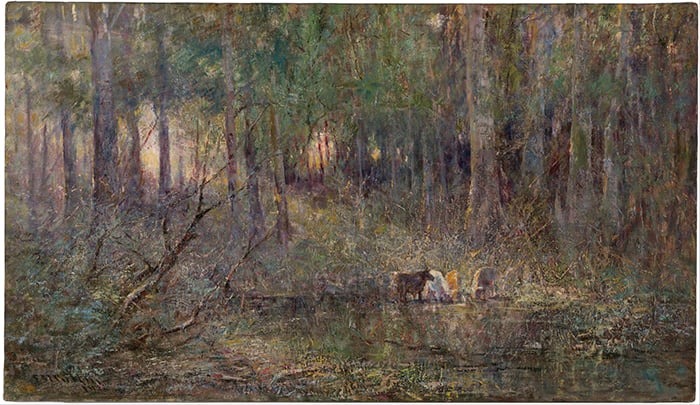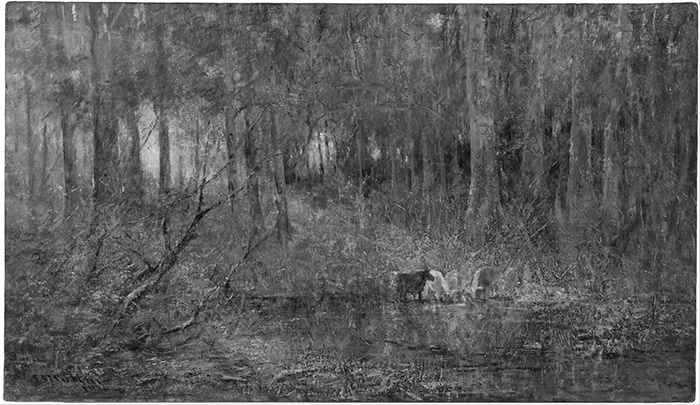This month’s featured painting is Violet and Gold by Frederick McCubbin. It’s a wonderful display of light flickering through the Australian landscape, with tall gum trees and cows drinking at the pond’s edge.
McCubbin wrote of his appreciation of gum trees:
“The subtle way in which it responds to varying effects of light and shadow was lost on them (other Australian artists) … the varieties in shades and colours, the Gum tree presented, from the violet grey tints of the stringy bark to the transparent sheen of the White Gum, upon which colours distort and change in a hundred subtle ways as they would upon a mirror. Yet our trees and our faded flora are such component parts of our Australian landscape.” (via James MacDonald, The Art of F. McCubbin)
These words provide insight into what McCubbin was trying to capture and achieve through his work.

Click here for a high-resolution photo of the painting. You can also see the painting as it hangs in the gallery here on Wikiart, though the image is grainy.
“There is no narrative, only poetry.” Ron Radford, Our Country: Australian Federation Landscapes, 1900-1914 (Amazon link)
Brief Details About the Painting:
- Oil on canvas.
- 1300 x 720 cm (511.8 x 283.4 inches).
- Completed 1911.
- Location: The National Gallery of Australia, ACT.
Your Thoughts?
Use this as an opportunity to test your ability to analyze master paintings. In the comments below, share what you think are the top 3 most important aspects of the painting. These could relate to areas such as composition, color, value, progress, brushwork, subject, or symbolism. Once you have done that, you can compare your thoughts with my own in the drop-down below.
Click here to see my thoughts.
Rays of Light
Rays of light shoot through the trees and illuminate the cows. It must be early morning or late afternoon when the sun is low on the horizon and the sky is filled with warmth.
This is a challenging thing to paint. Rays of light have no form, so you must be subtle in your rendering. Here, McCubbin scumbled highlights over the surface with, I assume, a dry brush. This suggests light flickering through the landscape. McCubbin also used directional brushwork to suggest the direction of the light.
Notice how the rays of light form these vague shapes. You might need to squint to see them (squinting simplifies the values and reduces the amount of information).

Dark Accents, Highlights, and Compressed Values
Most of the painting is compressed around a similar value range, plus dark accents and highlights. You can see what I mean in the grayscale below. This is a form of value simplification. Instead of painting every single change in value (lightness), McCubbin simplified the values into a few large masses. Another key observation from the grayscale is how “dark” the lights are. This gives the light a soft appearance rather than it being bright and glaring.

Competing Diagonals
The rays of light shoot down from the left-hand side. This forms a strong diagonal in the painting. It might not be a strong line, but it certainly has a strong presence as our eyes are naturally drawing towards light.
Shooting up from the bottom left corner is a tree and its intricate branches. This forms a rough diagonal that competes with the light.
The two diagonals also cross around the middle, creating an interesting play between the transient light and the rigid and dark tree branches.

Cows: Distinct and Part of the Whole
The cows drinking from the pond are a key feature. Notice how they are distinct yet part of the surroundings. Our attention is pulled towards their presence, but not so much that they appear out of place.
My one criticism of this painting though would be the rendering of the cows. They appear a bit stiff and rigid. Remember, it’s good practice to look for flaws or ways you might improve on master paintings. This will help you take the master artists down from the pedestal and view them as artists like us.

Technique Variance and Broken Color
McCubbin used a wide range of techniques. I can see scumbling, line work, flat color shapes, flickering highlights, crisp dark accents, and broken color. It’s not easy to use so many techniques in harmony, but when it works, it works.
Simplification and the Illusion of Detail
McCubbin didn’t paint every detail. Instead, he used his wide range of techniques to convey the illusion of detail. He also used a few key features to give context to the surroundings. For example, the horizontal strokes below the cows suggest ripples and reflections in the water. Without these details, the water would be hard to distinguish from the surrounding colors.

For me, I’m drawn into the painting starting at the bottom right, up left along the edge of the pond, then turning fight, towards the cows, around them and then left again up the slope to the bright hole in the trees. What lies beyond? Could be a pasture (the Gold) from which the cows have wandered down into the gum tree forest (Violet) and on to the water. That path – a lovely S curve.
So let me say first of all, WOW! I love it! This is the first time that my immediate reaction is “I want that painting on my wall.” My second reaction is “How did the painter do that?” How did he capture the play of light splashing through a grove of trees?
First, how did he make the barks of those trees glow with shimmering colors? So the trees glow by having dabs of multiple contrasting colors placed side by side: Blue green, peachy-purple, forest green, a dark reddish brown for the back side. If you ask, what is the main color of the tree trunks, it is almost impossible to say. They looks to be shimmering with a rainbow of colors that you have to assume is “really” white or brown in deep shade.
Second, how did he capture the illusion of light pouring through sticks and branches to the group of cows? Besides the white (actually a beige) concentrated on the cows, and extreme high contrast shading of the array of cows (the are each standing at a different angle to the light and are lit on only one side), the main trick is tiny slivers of yellow-gold or yellow-brown strategically placed on the light-facing side of some spots of some of the trees (used very sparsely), as well as in the negative space between some trees and leaves. In fact the light is fading out some tree trunks altogether, as if it is blindingly bright coming around those trees.
Finally, how did he create the illusion of thick, prickly underbrush? I am not entirely sure but I will guess that either he layered paint in a chaotic way with the edge of a pallet knife or maybe scratched wet paint with something.
I just love the way the sun shines through the trees, and wish I could paint like that
The first thing to see is the light moving the eye into the focal point of the cows. The contrast between the white and black cow makes this stand out even more. The composition is such that it is well balanced with the tree branches on the left again leading the eye to the light and focal point and also adding some more darks to balance the dark tree shadows on the right. The addition of texture in the foreground also contrasts again the background and the warm colours seem to suggest it is a summer’s day. The colours used also create contrasts, there is nothing not to like about the painting. I love the reflections in the water too, subtle yet not understated either. A gentle peaceful painting! Thank you, Dan, for giving us food for thought with your chosen challenges for us.
Love his paintings. Blending of colours soft and muted. Eyes are drawn to the cattle and the gum trees to the side. Brush strokes overlay in warm colours with a few dark patches.
It’s very atmospheric, with the cool colors, soft edges and diffuse light. I took me a minute to get into it because of the low contrast, but once I focused on the cows in the ray of light, and that tree outlined in the lower left, I began to appreciate the richness and subtlety. Masterful blending of colors.
The central point of this beautiful paint is the cattle then my eyes moved the the gum trees. Muted warm Colours and low contrast are my main comment about this paint with a well balanced. composition